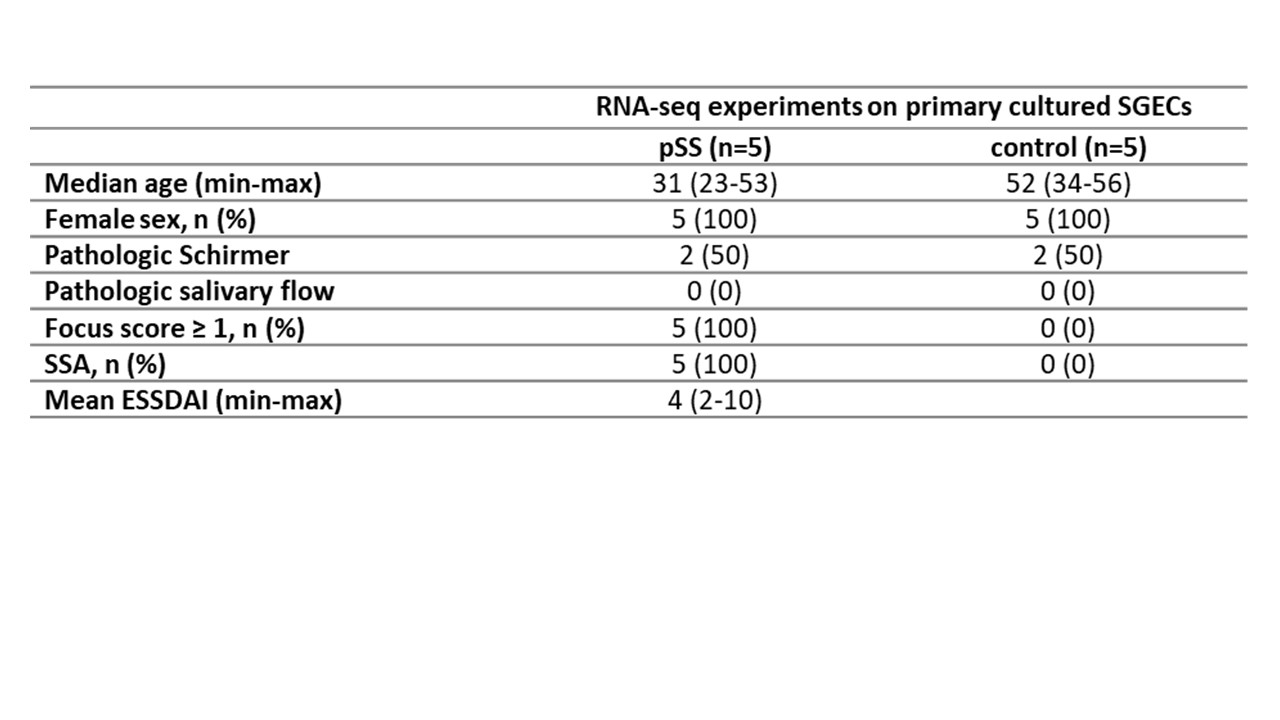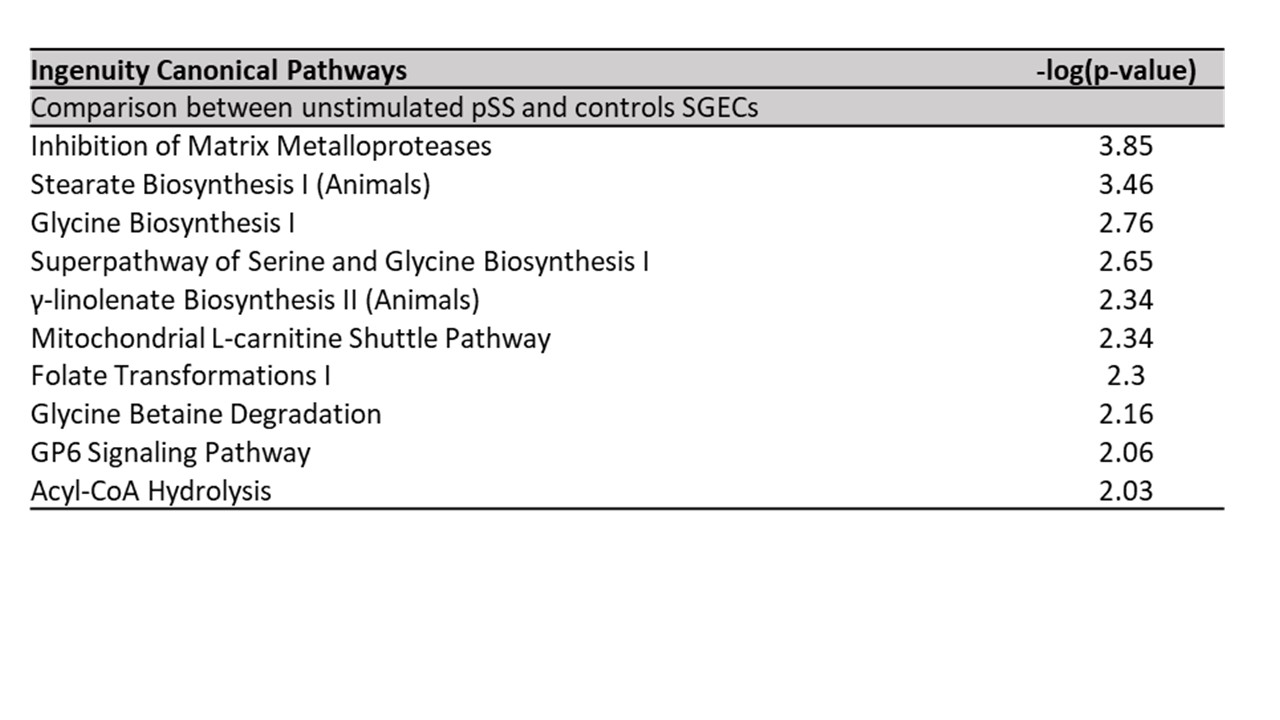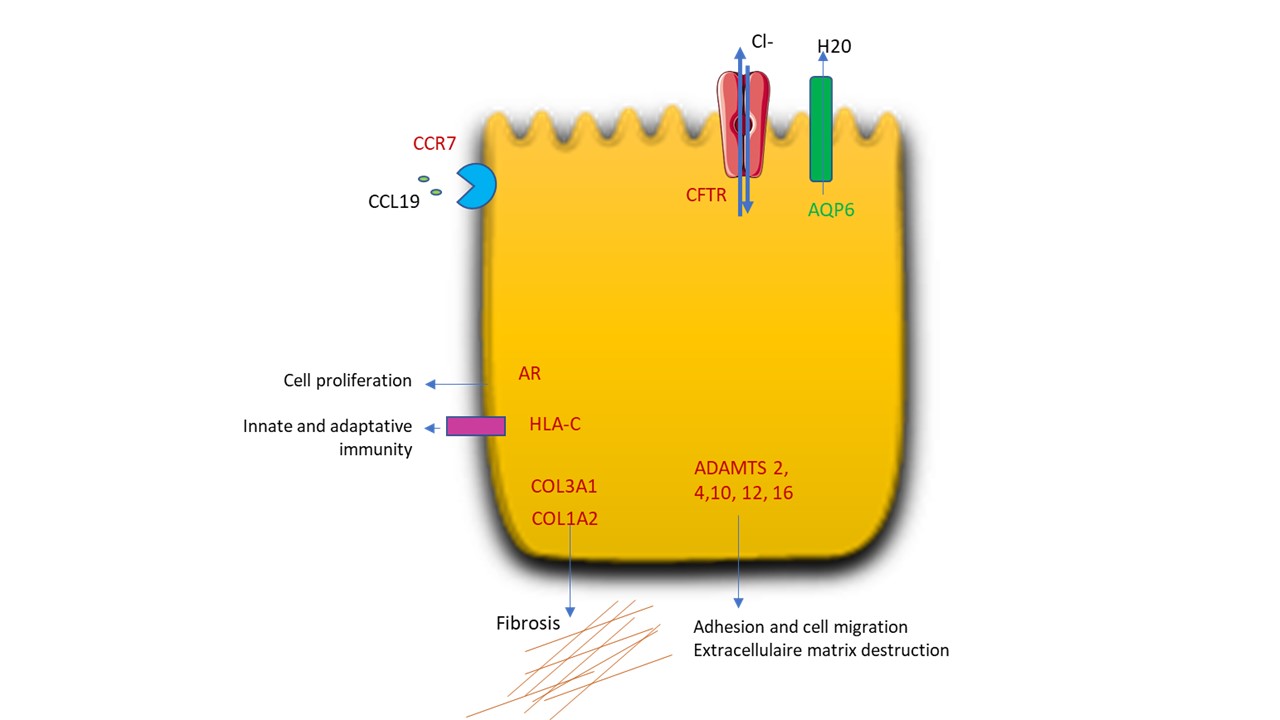Session Information
Date: Saturday, November 6, 2021
Title: Sjögren's Syndrome – Basic & Clinical Science Poster (0296–0322)
Session Type: Poster Session A
Session Time: 8:30AM-10:30AM
Background/Purpose: Salivary gland epithelial cells (SGECs) participate to the hyper activation of the immune system in primary Sjögren’s syndrome (pSS). This study aimed to analyze the transcriptomic characteristics of primary cultured SGECs from pSS patients compared to controls, in order to identify pathways involved in pSS pathogenesis.
Methods: Minor salivary gland (MSG) biopsies were obtained from patients referred for suspicion of pSS. pSS was defined according to the 2016 ACR/EULAR criteria. Controls had sicca symptoms without anti-SSA/SSB and with normal MSG. Primary cultures of SGECs were established from MSGs. After 2 to 3 weeks of culture, cells were dissociated and incubated at 37°C for 24h. Total RNA was extracted and reverse-transcribed. Libraries were sequenced on Illumina Nextseq 500. Statistical analyses of the RNA-Seq used DESeq2 package. Absolute FC value >1.5 and p-value< 0.05 was applied to identify up and down-regulated genes.
Results: Patient’s characteristics are presented in Table 1. The comparison of gene expression in primary cultured SGECs of pSS compared to controls showed 511 differentially expressed genes: 251 upregulated and 260 downregulated. Functional enrichment pathway analysis highlighted an over-representation of the Inhibition of Matrix Metalloproteases signaling pathway (Table 2). Among the most upregulated genes, we identified genes involved in extracellular matrix formation, including several collagen genes: COL3A1 and COL1A2 with the higher fold-change (FC) (log2FC = 2.40, log2FC = 2.12, respectively). There were also several ADAMDTS genes (A Disintegrin and Metalloproteinases with a Thrombospondin motif) related genes such as ADAMTS2, ADAMTS16, ADAMTS12 (log2FC = 2.09, log2FC = 1.57, log2FC =1.31, respectively). Other genes that might have a role in saliva secretion such as CFTR and AQP6 were differentially expressed. CFTR, which codes for a channel that conducts chloride ions across epithelial membranes, was upregulated (log2FC=1.67), whereas AQP6 was downregulated (log2FC=-1.44). There was an upregulation of HLA-C (log2FC=0.63), as well as CCR7 (log2FC=1.26). Lastly, we identified an upregulation of the androgen receptor (AR) gene (log2FC=1.71). A schematic representation of these results is presented in Figure 1.
Conclusion: Differentially expressed genes between pSS and controls SGECs included genes involved in the extracellular matrix formation. This result suggests a role for SGECs in salivary gland fibrosis development. We also observed a downregulation of AQP6. A potential role of AQP5 abnormal localization on saliva secretion in pSS has already been described, however, AQP6 potential involvement in pSS pathophysiology has, to our knowledge, never been described. CFTR upregulation in SGECs from pSS compared to controls could be reactive to the salivary gland damage and dysfunction. The differentially expressed genes identified in this RNA-seq analysis need to be confirmed by qPCR.
These results open the perspective of new potential pathogenic pathways involved in pSS, suggesting the involvement of SGECs in extracellular matrix and fibrosis constitution.
To cite this abstract in AMA style:
Rivière E, Pascaud J, Letourneur F, Nocturne G, Mariette X. Salivary Gland Epithelial Cells Transcriptomic Analysis Highlight Their Potential Involvement in Extracellular Matrix Modification in Sjögren’s Syndrome [abstract]. Arthritis Rheumatol. 2021; 73 (suppl 9). https://acrabstracts.org/abstract/salivary-gland-epithelial-cells-transcriptomic-analysis-highlight-their-potential-involvement-in-extracellular-matrix-modification-in-sjogrens-syndrome/. Accessed .« Back to ACR Convergence 2021
ACR Meeting Abstracts - https://acrabstracts.org/abstract/salivary-gland-epithelial-cells-transcriptomic-analysis-highlight-their-potential-involvement-in-extracellular-matrix-modification-in-sjogrens-syndrome/



